Coming soon to a pencil blog near you:
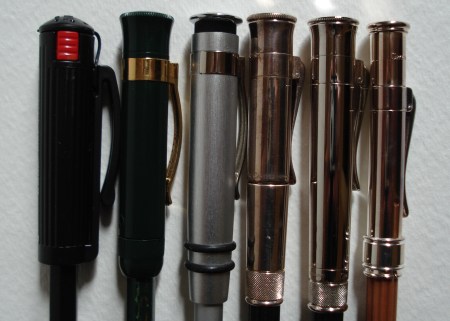

pencil talk | pencil reviews and discussion
exploring the art and science of pencils since 2005
Coming soon to a pencil blog near you:

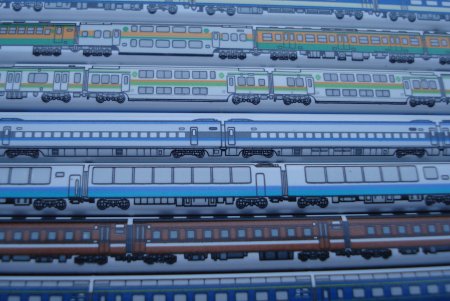
Pencils and trains have some commonality in the way they approach their tasks. A pencil touches paper as it writes, and a train touches the ground as it travels. A computer and printer can produce a document, just as an airplane can deliver one to a remote destination. But the journey, to document or destination, is not at all the same.
This pencil series celebrates Japanese trains. Made by Tombow, there are four boxes in this issue, each box celebrating two different trains. The pencils are in the rounded square style, like the Pantone pencils we saw earlier this year. This shape accomodates the train graphics very well.

Each pencil has two train side views, a schematic view, and text on the fourth side. The boxes also come with display cards for the pencils that include “tracks”. They’re not extremely useful, but they do add to the uniqueness of the set.
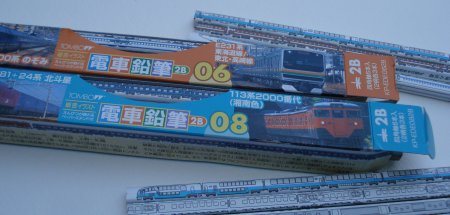
The set is a real joy. Announced in late March, they are sure to sell out quickly.
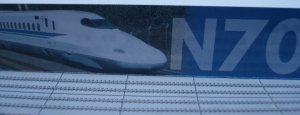

The camel is renowned as a hardy animal, able to persevere through challenging circumstances.
The pencil world seems to adore the camel, as there are a significant number of camel brands.
First, the Staedtler Camel. This brand has been aound for many years, and now appears to be made in Germany for export markets.
Second, an entire company named after the camel, the Camel Pencil Company of Japan. They seem to make mainly novelty pencils, yet do have a few nice looking adult-oriented pencils. (That CA-P4 pencil looks good.)
Camel Pencil, according to their website, was organized in 1939, and established in 1949. They now have a U.S. distributor, so I think we’ll be hearing more from them in the future.
Third, another company named after the camel, Camlin Ltd. of India.
Camlin dates from 1931, and their website states:
The “Camel” was chosen as a symbol due to its capacity to endure long periods of difficulty in the trips across deserts. “Camel” was also easy to write and pronounce in all the Indian languages and was acceptable to all the religions of the land.
This is remarkably forward thinking, and reflects ideas that are at least as relevant in 2008, when many brands are attempting to compete in global markets.
I have a few Camel of Japan pencils – but have never seen a Staedtler Camel or Camlin pencil.
Has anyone used (any) Camel pencils?

The final part of our evaluation of Japanese woodcase pencils.
Let us mention some things we aren’t testing. First, we’re not testing a wide range of lead hardnesses. Nor are each of these pencils made in a wide range. I would say the chart below speaks for itself: Only two brands offer a full range of hardnesses.
| Range | |||||||||||||||||
| Pencil | 9H | 8H | 7H | 6H | 5H | 4H | 3H | 2H | H | F | HB | B | 2B | 3B | 4B | 5B | 6B |
| California Republic Palomino | X | X | X | X | X | Craft Design Technology item 17 | X | ||||||||||
| Kita Boshi Hit 9900 | X | X | X | X | X | X | |||||||||||
| Mitsubishi Hi-uni | X | X | X | X | X | X | X | X | X | X | X | X | X | X | X | X | X |
| Pentel Black Polymer 999 | X | X | X | ||||||||||||||
| Tombow Mono 100 | X | X | X | X | X | X | X | X | X | X | X | X | X | X | X | X | X |
If you want a pencil for long term use or an ongoing project – and want the pencil to be on the market in ten years – that’s very hard to guarantee, but the established pencil makers would certainly be my choice, and I fully expect the Hi-uni and Mono 100 to celebrate many more anniversaries. Pentel is an established company also, but the withdrawal of the 999 alpha doesn’t portend well.
Writing (40 points)
Manufacturers no doubt have specialty instruments for product testing. The rest of us have to trust our senses and observations. This is no doubt quite subjective. I decided to break writing into smoothness, darkness, point, and overall impression sub-categories.
In many cases, I found myself staring at pieces of paper full of pencils marks, looking for very small differences. A first conclusion, apart from the naming of an ultimate victor, is that the reputation of Japanese pencils is well deserved, and that these pencils are better, and in some cases remarkably better, than their marketplace competitors.
Smoothness is definitely appreciated by pencil users. It is the formula of the pencil core that makes the difference here. We want to avoid any gritty or abrasive reaction between the pencil and paper. I tried various techniques, including making marks without viewing, and getting others to test the pencils.
Fortunately, there were some consistent results. A surprise also – no one felt the Mono 100 to be among the smoother pencils. It may be a grading difference, or a reflection of paper choices (110lb artist sketch books were used as well as writing paper), but the result was clear. The three smoother than average pencils were the Palomino, item 17, and Hi-uni. The smoothest pencil? I am really surprised to say that it is the item 17 pencil – a new entry on the market. The Hi-uni was very close second.
Many pencil users appreciate a dark line, but it isn’t always fair to say that one pencil is darker than another, since different brands may have different grading practices. Still, these pencils are all produced in same market, and it is an HB test.
The darkest line comes from the Black Polymer 999. Is the pencil made with another formula, perhaps like a mechanical pencil lead, with polymer substituting for clay? I have no idea, but it ceratinly made the darkest line. The Mono 100 was second, and I couldn’t find much difference among the other pencils.
By “point” – I mean the pencil’s ability to maintain a point, and to not crumble with use.
This is the weak point of the Palomino – the pencil does not hold a point very well, and also visibly crumbles when applying a heavy hand. A top professional animator has made this very observation at this site. No other pencil has the crumbling issue. The item 17 is probably next at wearing down quickly. The name brand pencils excel in this area, with the Black Polymer 999, Hi-Uni and Mono 100 keeping good points.
Alas, the nature of pencil use is that the point always does wear down. But the worn point initiates the ritual of sharpening, which delights us with a renewed sharp point. And the cycle continues.
As to overall impression – compared to many pencils I’ve looked at, these are all a joy to use.
The Hit 9900 and Balck Polymer 999, while first rate, are in very tough company here. Each was best in a category – yet there is much more to a pencil than “grip” and “blackness”. The item 17 and Palomino have great smooth leads, but at a price – for the Palomino in particular.
The Mono 100 was an all-rounder. It performs well at any task – and you get more pencil. I’m not kidding. International standardization of pencil slats has meant a uniformity of the length all pencils around the globe. But the Mono 100 must use a non-standard slat, as it four or five mm longer than other pencils. The HB lead seemed a tad less smooth than others, so it gets a small penalty for that.
Our results:
| Writing | |||||
| Pencil | Smooth | Dark | Point | Overall | Score |
| California Republic Palomino | 8 | 8 | 5 | 8 | 29 | Craft Design Technology item 17 | 10 | 8 | 6 | 8 | 32 |
| Kita Boshi Hit 9900 | 7 | 8 | 7 | 7 | 29 |
| Mitsubishi Hi-uni | 9 | 8 | 8 | 9 | 34 |
| Pentel Black Polymer 999 | 7 | 10 | 8 | 7 | 32 |
| Tombow Mono 100 | 7 | 9 | 8 | 8 | 32 |
Our tests concluded, it it time to assemble the scores for the final results:
| Top Japanese Pencils | |||||||
| Pencil | Appearance | Grip | Sharpening | Erasure | Fastness | Writing | Score |
| California Republic Palomino | 17 | 8 | 8 | 7 | 10 | 29 | 79 | Craft Design Technology item 17 | 19 | 8 | 8 | 9 | 10 | 32 | 86 |
| Kita Boshi Hit 9900 | 15 | 9 | 8 | 8 | 10 | 29 | 79 |
| Mitsubishi Hi-uni | 14 | 7 | 10 | 10 | 9 | 34 | 84 |
| Pentel Black Polymer 999 | 16 | 7 | 8 | 8 | 8 | 32 | 79 |
| Tombow Mono 100 | 14 | 8 | 8 | 8 | 10 | 32 | 80 |
The top pencil in our test is the Craft Design Technology item 17. The win is based on strong overall scores, and top spot for appearance. The Mitsubishi Hi-Uni came a close second, and was best in three categories, including writing.
As I performed the various tests, I avoided added up the results, and was really surprised to see the evaluation results. I did initially think that one of the highly regarded Mono 100 or Hi-uni was bound to win.
Congratulations to this superb new pencil from Craft Design Technology/Pentel.
Continuing our evaluation, we are going to look at two more aspects of the top modern Japanese pencils.
Erasure (10 points) (Line – 5 points, Block – 5 points)
We’ve already established that erasure is a question of at least three factors – pencil, paper, and eraser (there may also be hidden factors like temperature and humidity). It would be great to evaluate a complex matrix of papers and erasers against these pencils, but I’m going to settle on one good eraser – the Staedtler Mars plastic, and one good writing paper – Rhodia 80 g/m2. The results would no doubt be different on a toothy art paper, or newsprint, or office copy paper. But a high quality writing paper and the excellent Staedtler Mars plastic eraser are appropriate choices for a test of HB pencils in a writing context.
Two types of marks were made – ruler drawn lines, and shaded blocks. The eraser was then applied.


The results are subtle, though there is a clear winner. All lines erase well with a quality eraser. The Hi-uni erased best in the line category line, with the Palomino trailing the field. item 17 did the best at block erasing, with the Hi-uni a hair behind.


| Erasure | |||
| Pencil | Line | Block | Score |
| California Republic Palomino | 3 | 4 | 7 | Craft Design Technology item 17 | 4 | 5 | 9 |
| Kita Boshi Hit 9900 | 4 | 4 | 8 |
| Mitsubishi Hi-uni | 5 | 5 | 10 |
| Pentel Black Polymer 999 | 4 | 4 | 8 |
| Tombow Mono 100 | 4 | 4 | 8 |
Fastness (10 points) (Paper – 5 points, Finger – 5 points)
Fastness, which we’ll define as resistance to smudge and smear, are important for several reasons. In any sort of notebook or journal, the pages will rub against one another, and writing or drawing could potentially become damaged or ruined. For those who write with their left hand, fastness is very important (at least with left-to-right languages) as the writing hand crosses the page.
Fastness could be defined much more broadly – such as resistance to aging and environmental factors such as sun and rain, but these conditions are beyond our ability to test.
Lines were again drawn on paper, and a blank piece of paper was repeatedly rubbed against the marks, in an attempt to simulate notebook conditions.
In a second test, an attempt was made to smudge another set of lines by running a finger across the lines.
The overall news is good. All of these these pencils are quite smudge resistant. Can you guess which pencil did very slightly smudge against paper? That’s right, the most erasable pencil – the Hi-uni. (There was also a minuscule smudge from the 999.)
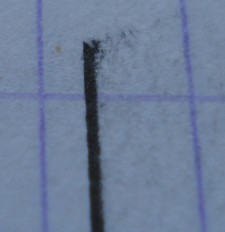
I really smiled when I realized that the two tests are to a large extent testing the same thing – graphite adherence to paper. So of course, the most erasable pencil is also the most smudge prone pencil.
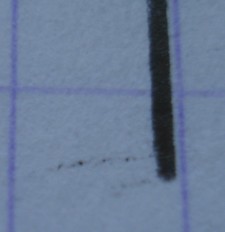
The 999 turned out to be the only pencil I could smudge with a finger – and very slightly at that.
| Fastness | |||
| Pencil | Paper | Finger | Score |
| California Republic Palomino | 5 | 5 | 10 | Craft Design Technology item 17 | 5 | 5 | 10 |
| Kita Boshi Hit 9900 | 5 | 5 | 10 |
| Mitsubishi Hi-uni | 4 | 5 | 9 |
| Pentel Black Polymer 999 | 4 | 4 | 8 |
| Tombow Mono 100 | 5 | 5 | 10 |
To be continued
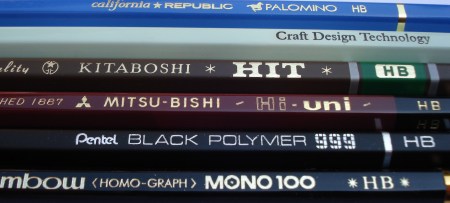
One of pencil talk‘s most popular subjects has been Japanese pencils. Made to extremely high standards, these pencils are the preferred working tools of many artists, drafters, and other professionals around the globe. Thanks to the world wide web, it’s now possible for those of us outside Japan to acquire these first rate writing implements.
In this review, we will compare and contrast the HB versions of six Japanese pencils:
California Republic Palomino
Craft Design Technology item 17
Kita Boshi Hit No. 9900
Mitsubishi Hi-uni
Pentel Black Polymer 999
Tombow Mono 100
We will look at appearance, grip, sharpening, erasure, fastness, and writing capabilities, and attempt an overall assessment by assigning points in each category to the pencils.
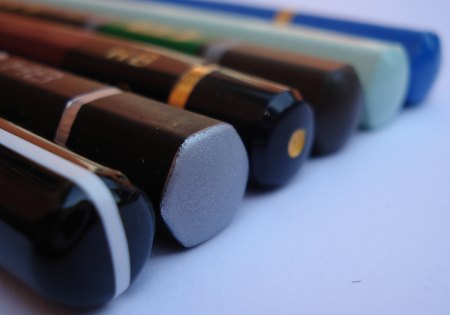
The pencils.
1. The California Republic Palomino is made in Japan for California Cedar Products. Introduced in 2005 and sold primarily through an eBay store, the manufacturer is unknown.
CalCedar states that they are “the world’s leading supplier of wooden slats for the production of wood-cased pencils.” So they are a supplier to the pencil industry, and may very well have provided the wood used in all six of these pencils.
The product home page is here.
2. item 17 is the highly generic name used by Craft Design Technology. The pencil is made by Pentel for CDT, and is part of a large line of office supplies provided by a number of manufacturers, including Pentel, Sun-Star, Lion, Sanwa, Yamato, Zeba, and Takeo. Tyler Brule is among their creative team.
CDT has a website here. Note: the website uses extensive flash animation, window resizing, and popups.
3. The Hit 9900 is made by Kita Boshi. Though they specialize in children’s pencils, the Hit is a first rate pencil, and worthy of inclusion in this list.
Kita Boshi have a website here. Take a look at their interesting headquarters building, which they call “Pencil House”.
4. The Mitsubishi Hi-uni is made by the Mitsubishi Pencil Company – no relation to the Mitsubishi Motor Company. They were established in 1887, and trade on the Tokyo Stock Exchange. The Hi Uni, along with the Mono 100, has long been considered to be at the pinnacle of pencil making. Of course, our challenge today is to see if this reputation is deserved.
Product page here.
5. The Black Polymer 999 is make by Pentel. A heavyweight in the mechanical pencil world, I cannot find too much online about their woodcase manufacturing operations. The continued availability of this pencil, and their production of CDT’s pencil, indicate that Pentel is still active in this area.
6. The Mono 100 is the offering from Tombow. It has many adherents in the animation field who feel it is the world’s best pencil. Tombow was founded in 1913, and launched the Mono 100 in 1967.
Tombow’s website includes a lot of English language content for those of us who don’t speak Japanese, and includes some interesting print and television ads for their local market.
Here is their pencil page.
There are other pencils I wish could be added to this review – The Pentel 999? (999 alpha) was Pentel’s premiere offering, but appears to have been withdrawn from the market. I haven’t been able to locate any. The Colleen Pencil Company folded a few years earlier, but was greatly admired for their quality. More information is available at this site devoted to Colleen pencils. The Japanese pencil industry website also lists other manufacturers, but most appear to be in the novelty market.
Appearance (20 points)
We’ll evaluate the pencils themselves, but I thought I’d start by mentioning the packaging. The Mono 100 and Hi-uni come in sturdy, reusable cases that will actually protect the pencils. If you’ve never seen these, they are an immense surprise. The CDT and Pentel pencils come in standard but attractive pencil-matching cardboard boxes. The Hit 9900 comes in a generic unlabeled white cardboard box. The Palomino used to ship in a plastic box of six, though it now also has a wooden box option, and possibly others.
I will cut right to the verdict here – the opinion of everyone who has seen these pencils (including myself) is that the CDT pencil is an immediate standout – clear, clean design with minimal black text, and a fantastic original choice of colour.
Next to the CDT pencil, I give a nod to the Palomino, again for clear, clean design with minimal text. It gets second because the colour (it comes in both blue and red-orange) isn’t quite as original as the CDT pencil, nor is the gold colour text. It also has a painted ring, which emulates the embedded gold colour rings of the Mono 100 and Hi-Uni. However, I think it is a distraction, and the paint wears off over time.
All six pencils are made to very high standards – rich, highly finished deep varnishes, with no paint spilling over the unfinished end.
Bar codes may be a business necessity, but the Palomino, item 17, and Hit 9900 pencils avoid them – perhaps because they aren’t available as open stock at retail. Regular readers of the blog know that we don’t like bar codes on pencils. They interfere with the pencil’s look, and the impression on the pencil casing can interfere with the grip.
The Hi-uni and Mono 100 have an additional distinguishing feature – signature caps. In each case, a gold colour ring (I’m not sure of the material) is embedded near the crown. The Mono 100 has a white stripe traversing the cap, and the Hi-Uni has an embedded yellow dot in the cap. I do think this pride in the product is great.
The Hit 9900 and High Polymer 999 are distinguised by matte finishes, while the other four are glossy.
All six pencils are made to very high standards, and there is no doubt that each one exudes quality. In the end, the amount of text and the presence of barcodes on the brand name pencils reduces their scores.
| Appearance | |
| Pencil | Score |
| California Republic Palomino | 17 | Craft Design Technology item 17 | 19 |
| Kita Boshi Hit 9900 | 15 |
| Mitsubishi Hi-uni | 14 |
| Pentel Black Polymer 999 | 16 |
| Tombow Mono 100 | 14 |
Grip (10 points)
The decision by Pentel and Kita-Boshi to eschew a glossy finish for a matte finish may cause the pencils to look a little less shiny on display, but the better grip is a real potential benefit to users.
The nod in this category goes to the Hit 9900 due to the matte finish and no bar code. The 999 doesn’t get full benefit of the matte finish due to a stamped bar code, and I found myself rotating the pencil to avoid touching that part of the pencil. The Palomino and item 17 are close seconds due to their consistent finishes, which allow consistent grips no matter how the pencil is rotated.
| Grip | |
| Pencil | Score |
| California Republic Palomino | 8 | Craft Design Technology item 17 | 8 |
| Kita Boshi Hit 9900 | 9 |
| Mitsubishi Hi-uni | 7 |
| Pentel Black Polymer 999 | 7 |
| Tombow Mono 100 | 8 |
Sharpening (10 points)
This evaluation was truly a challenge. There are many types of sharpeners and sharpening technology available. It may be that most users of these high-end pencils are in animation studios, and use electric sharpeners. I use handheld sharpeners, and though it better that I stick to them.
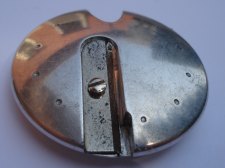
I started with a KUM Inox, which is representative of the type of sharpener I tend to like – compact, yet heavy enough to get a reasonable grip. But it has a very minimal sleeve for guiding the sharpener to the blade, and it didn’t seem to produce results that would be photo-worthy. I also considered that a Japanese sharpener would be appropriate, but the only ones I have are made by Tombow, and I thought they might subtly favour the precise dimensions of the Tombow pencil.

One sharpener I have that does work consistently well, perhaps because it does have more a significant sleeve for guiding the pencil, is the Faber-Castell UFO. The problem was that the blade was somewhat used, and it seemed unfair (though perhaps realistic) to use a dull blade. Enter the Laywine’s Special Order department, who were able to supply me with a replacement blade.
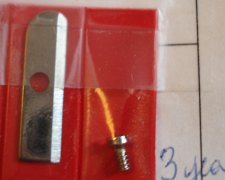
We are testing the pencil wood and lead, and the expectation is that the wood will be smoothly shaved away. We hope the point to be sharp and centered, but after taking pencil photos for a while, I’m quite aware that pencils rarely sharpen “perfectly”.
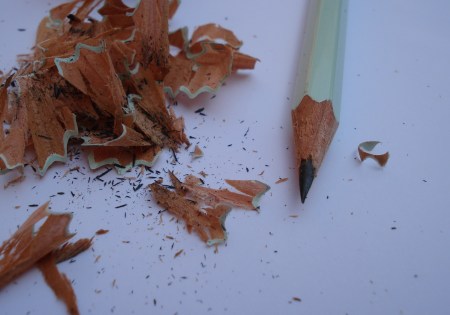
The wood – there are two standouts here – the Hi-uni and Mono 100 produce very red and rich cedar shavings. Is it the result of a different cedar variety or some sort of treatment?

The toughest sharpening was with the CDT pencil, while the Palomino was sharpened in an almost continuous spiral shaving. Yet the range was narrow, and all did well.
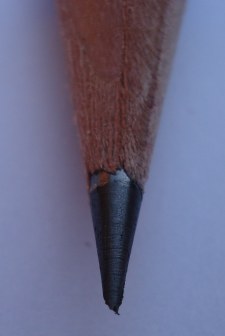
As to the point produced – the Hi-Uni is just perfect. I’ll draw on some past experience here. When it seems your hand is unsteady, or a sharpener blade is dull – try the same sharpener on a Hi-Uni, and it will usually produce a result that makes you wonder about what’s wrong with other pencils.
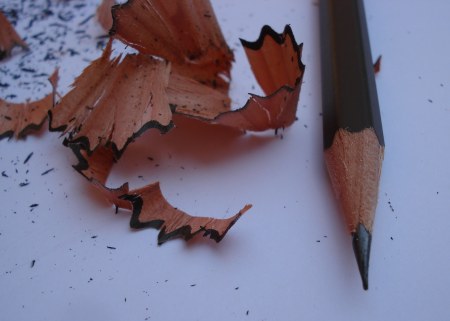
All the other pencils sharpened well, yet slightly excessive amounts of wood were removed. I’m giving them all the same score, an an exceptional ’10’ to the Hi-uni.
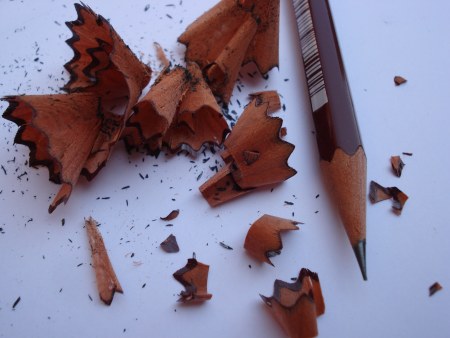
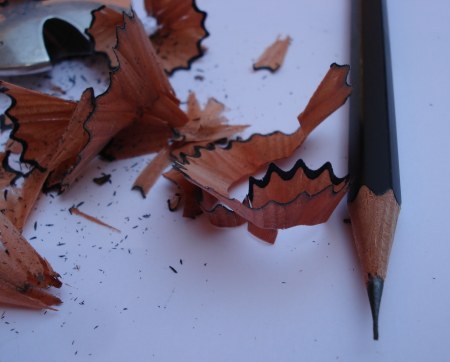
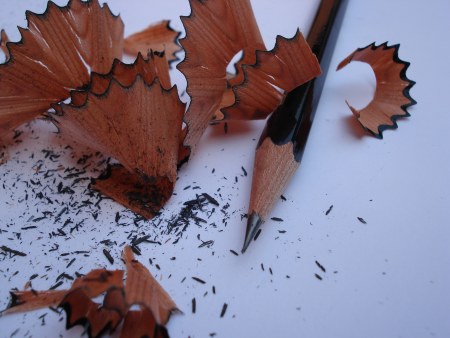
| Sharpening | |
| Pencil | Score |
| California Republic Palomino | 8 | Craft Design Technology item 17 | 8 |
| Kita Boshi Hit 9900 | 8 |
| Mitsubishi Hi-uni | 10 |
| Pentel Black Polymer 999 | 8 |
| Tombow Mono 100 | 8 |
To be continued